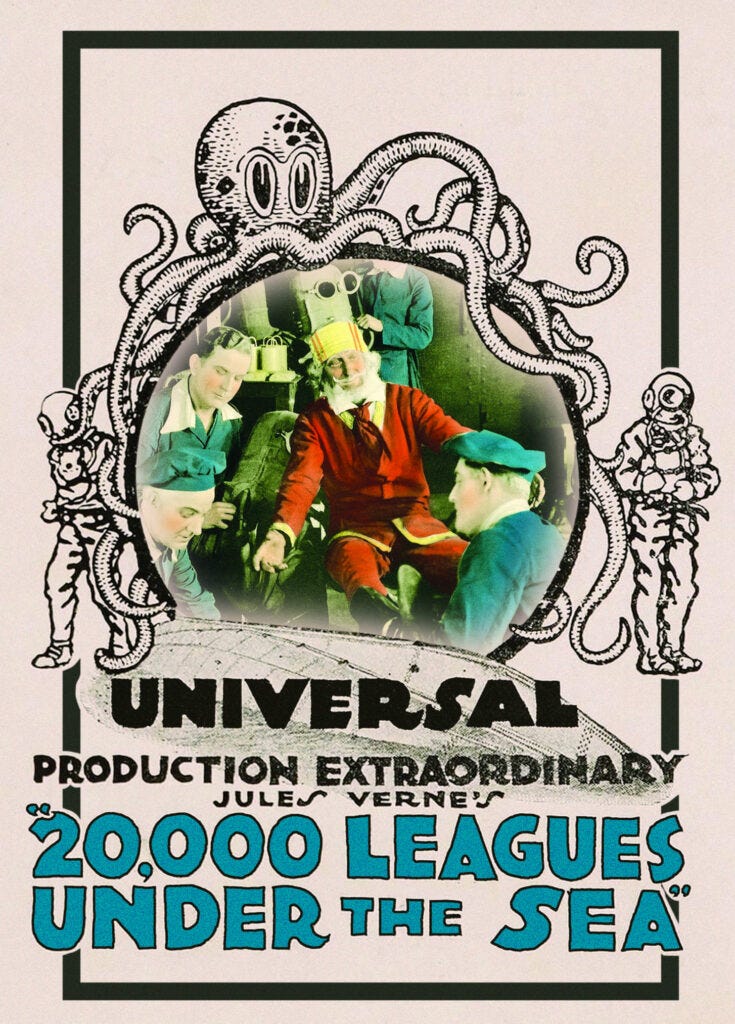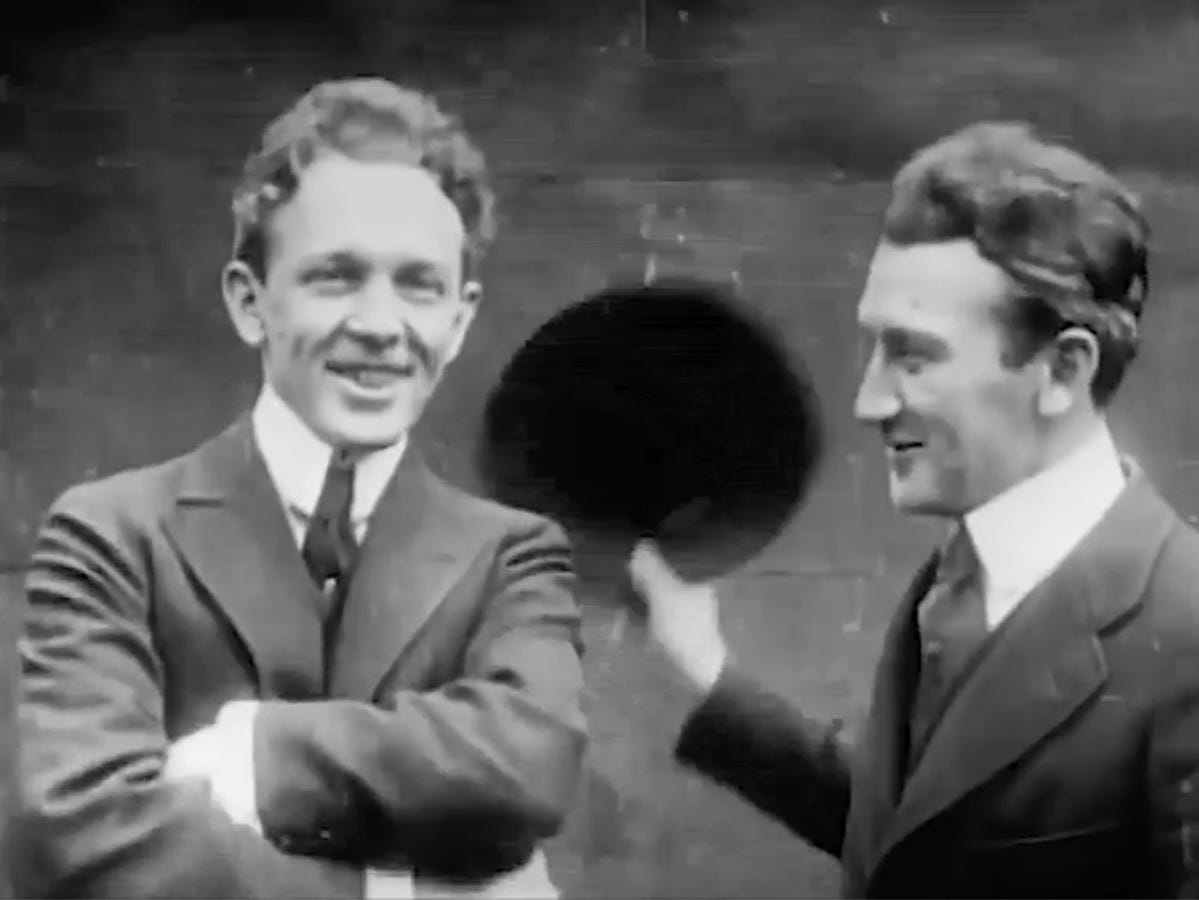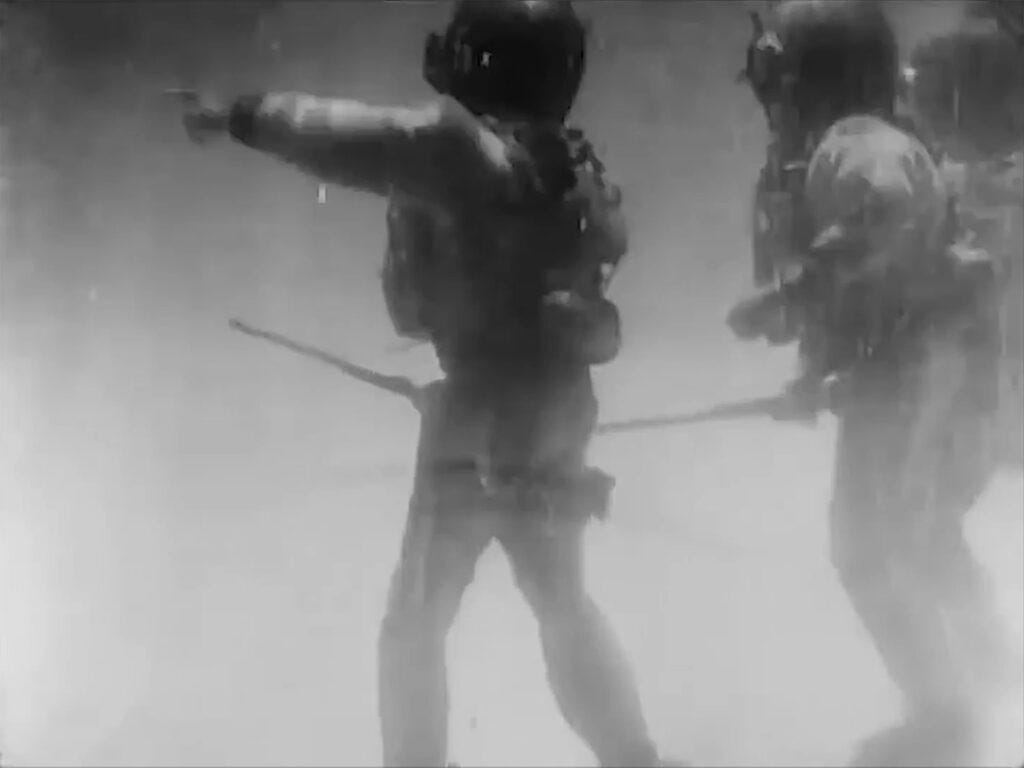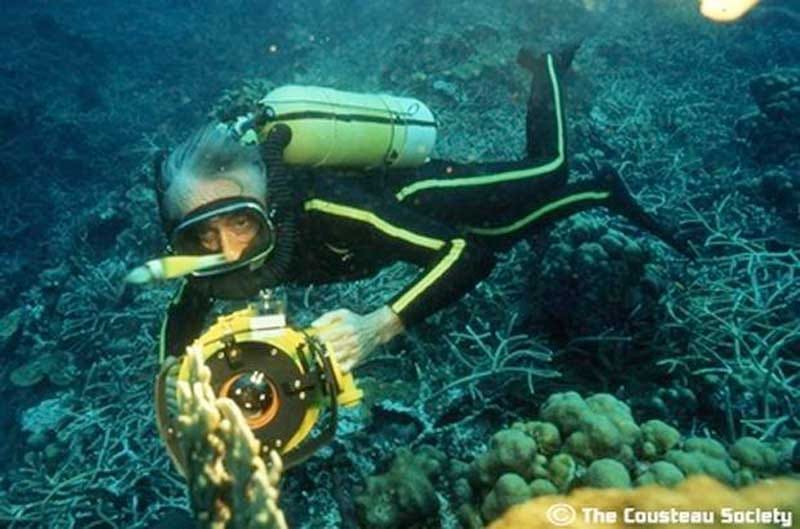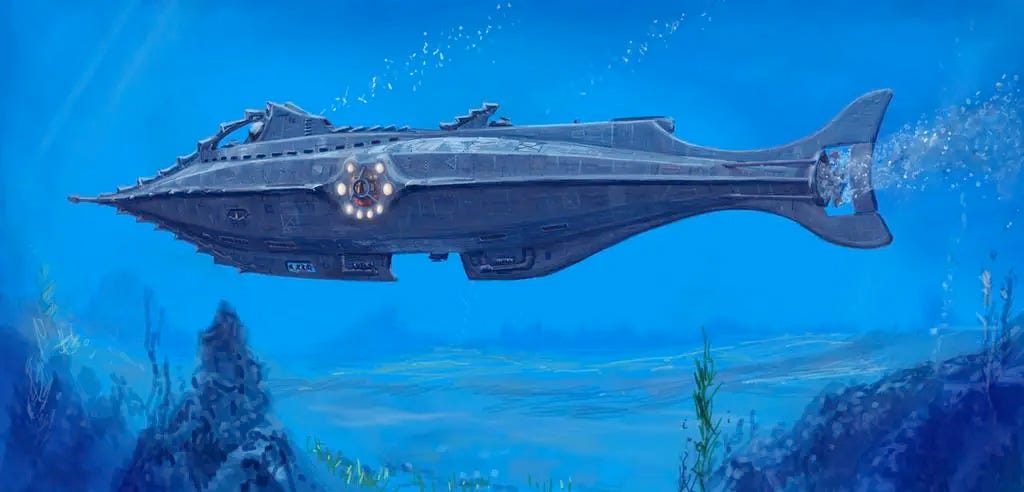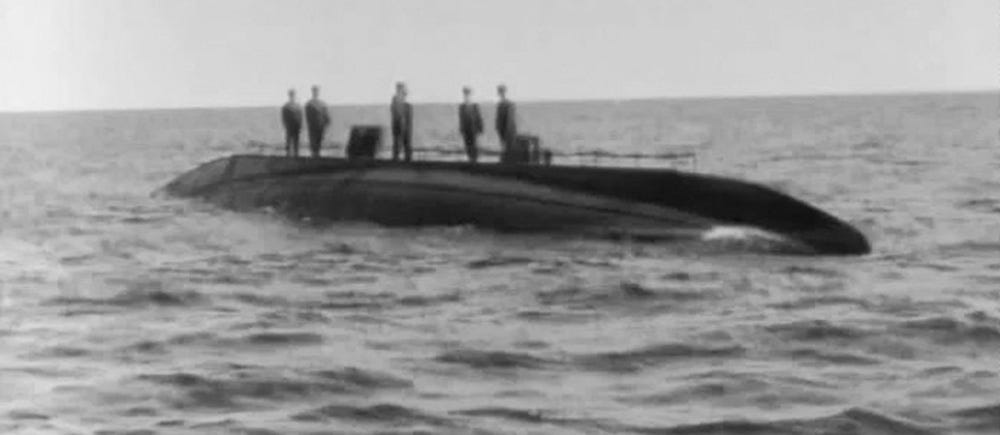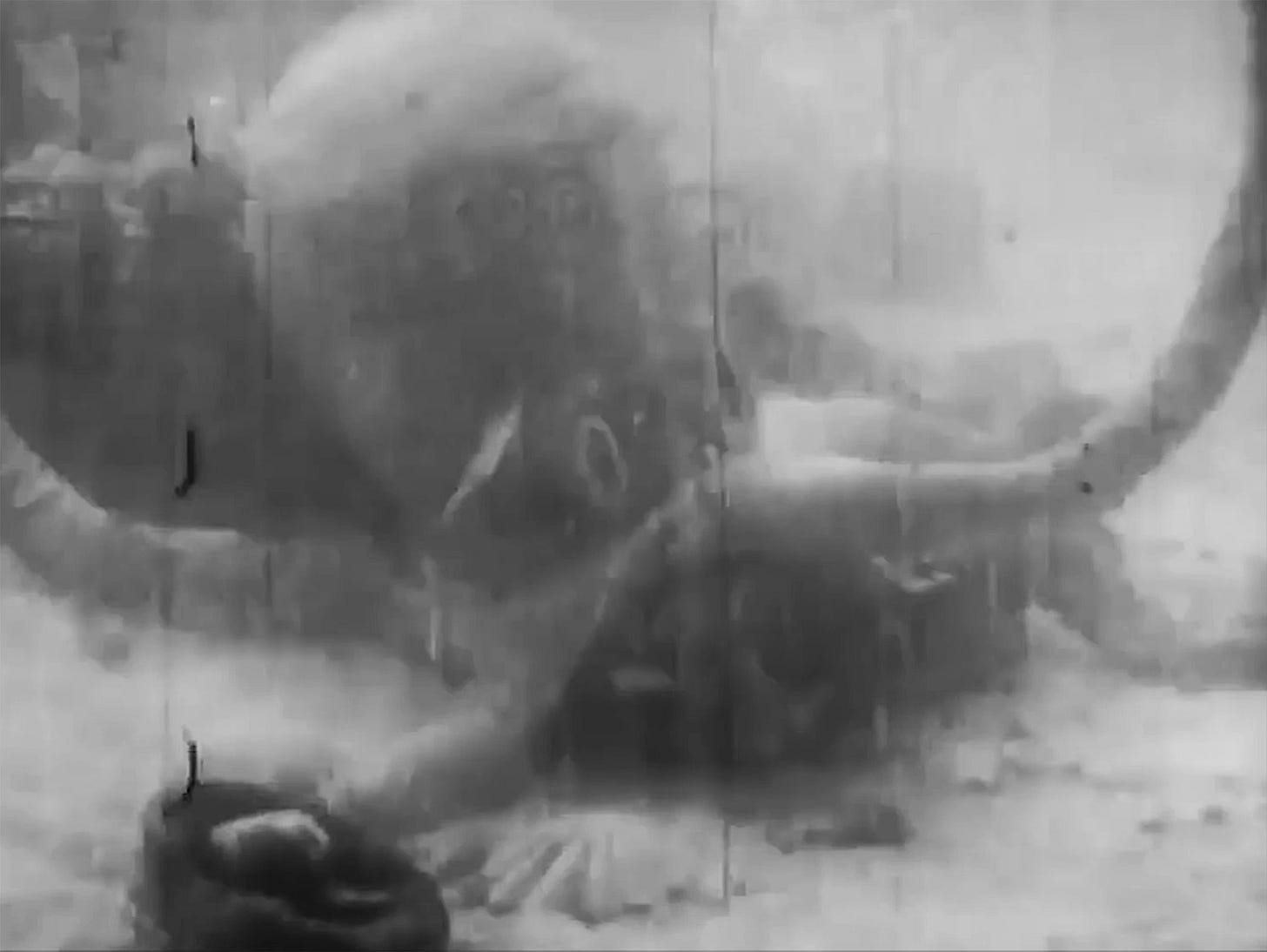GROSS/4 1916 - 20,000 Leagues Under the Sea - this review turned into a disquisition on underwater storytelling
This 20,000 Leagues Under the Sea wasn't even the first movie version.
GROSS is every year’s top-grossing movie, since 1913, reviewed.
20,000 LEAGUES UNDER THE SEA, STUART PATON AND THE WILLIAMSON BROTHERS, UNIVERSAL PICTURES, 1916, 100 MINUTES
The project continues. I'm watching the top-grossing movies of every year since 1913. I'm up to 1916 and it's a vastly ambitious (and ruinously expensive) Jules Verne adaptation.
Look, it's not a great film - in many ways it's horrible - but it's a landmark in all sorts of ways, not least because of these two lads.
The Williamson Brothers, George and Ernest - "who alone have solved the secret of under-the-ocean photography" it says in a card at the beginning of the film - had invented a way to shoot under water (it was based on a patented invention of their father's). It took them years to perfect it - by the time this project came around they'd shot tens of thousands of feet of film under water and released two or three one-reelers of their own using the kit in 1914 and 1915, to the amazement of audiences everywhere. This film, an early Universal production, was directed by Brit Stuart Paton, but this is really the Williamsons' movie.
These guys are the Douglas Trumbull or George Lucas of their era - geeks who love film. The still above is from the opening credits of the movie, which tells you something about their status in the project - not mere technicians. There's a real commitment to the new tech here. The Williamsons knew that audiences were eager for new sensations and ownership of a whole new category - stories set beneath the waves - might make them some serious money. They developed a slightly unhinged, multi-year obsession with making it work. I'd like to know more about the Williamsons and suspect there's a pretty good film in their inventiveness and their lunatic drive - perhaps made by the Coen Brothers.
The Williamson method involved a patented 30-foot long, collapsible tube ("a portable hole in the ocean", they called it) with an iron chamber at the bottom end of it. The chamber was cranked down into the water with a camera operator crouching inside it, presumably praying the studio's insurance was up to date (some accounts of the tech suggest it was all done with mirrors - which seems to be untrue. The detail here is pretty convincing). Specially developed film stock meant the Williamsons could achieve an exposure of 1/50th of a second, making shooting moving pictures perfectly feasible at 16 frames per second. The operator used a conventional camera and shot the undersea world through a thick glass window. No one had to get wet and no special cameras were needed. Scenes were shot in shallow, sunlit water so lighting wasn't needed - The effect is impressive - and must have been mindblowing in a darkened cinema in 1916. Huge sharks, schools of smaller fish, a reef and a ship wreck are all seen with amazing clarity.
The way the great sharks in particular circulate in the dappled light of the shallows and then loom menacingly out of the haze is beautiful and chilling. The intertitles use the language of the unmotivated shark attack, man-eaters, killing machines, suggesting that the irrational fear of these beasts long pre-dates Jaws - a whole new genre of fiction is proposed right here.
Later in the film, scenes are shot on the sandy bottom as if on a studio soundstage. Actors (stunt performers?) in big diving suits are directed in an awkward analogue of the dry-land process. Shooting began almost 40 years before the invention of scuba diving so these are not the diving scenes we're all familiar with now in which actors move naturally, oriented parallel to the surface, kicking to achieve smooth motion and exploring with the freedom of a baracuda or an eel.
So the undersea action doesn't take place in the magical unanchored world of the water column, with free movement in all directions. It all takes place in the two-dimensional setting of the sea bottom. Motion is achieved by literally walking from mark to mark (in weighted boots). Everything's basically shifted sideways (and down a bit) to the bottom of the ocean.
Meanwhile, Paton's eccentric adaptation of the Jules Verne - he blends the storylines from the original book and its sequel 'The Mysterious Island' and develops Nemo's Indian Prince back-story. Balloonists from the Union Army, escaping a civil war ambush, crash on the island (I kid you not). There's a strange and unsettling sequence set on the island where a 'child of nature', played by Jane Gail, who was already a big star (and was in 1913's top-grossing Traffic in Souls, which I reviewed here) is bothered by various boorish and/or murderous blokes until we learn that she is actually Nemo's daughter and the story begins to resolve itself in the standard melodramatic way. In one bizarre scene, Gail, blacked-up and wearing an inexplicable leopardskin shift, is shown how to wear trousers and a nice white shirt. She quickly takes to the new duds.
There's much in Verne's stories about Imperialism, liberty and self-determination. Nemo flees India after an unsuccessful uprising against British rule, he sacrifices all for the liberty of the undersea world. I can imagine a viable, low-budget remake - a festival hit with a post-colonial technofuturist vibe. Nemo was transposed, between the first book and the second, from Polish to Indian. Might he be further transposed to the role of undersea warrior for the Global South? A deep-sea superhero with an agenda?
In this film, which simplifies the geopolitics, let's face it, the freedom idealised is not the ideal of the book's French Republican author or even the dippy 20th Century freedom of the nature-worshipping scuba diver but the purposeful freedom of the 19th Century adventurer-explorer - conquering an unknown terrain by just walking off into it with a gun (the divers carry weapons that look like Winchester rifles from a cowboy film - we learn they're powered by compressed air). There's a hunting scene in which Nemo and his amazed guests stalk sharks in the manner of big game hunters on safari.
The unconstrained motion, the fish-like propulsion and the elegant forward movement of a scuba diver would have seemed weird, alienating, to audiences in 1916, as these straight-backed hunters walking the underwater range seem odd to us. If you studied the way the undersea imaginary in the movies has evolved since this film you'd presumably locate some kind of pivot - from ungainly and upright to elegant and unconstrained - in the motion of cinematic divers. But when did it occur? 1930s? WW2? Jacques Cousteau's 1960s'? And was there a resistance to the idea that divers ought to set aside humanity's pretty well-established bipedal mode for the swishing to-and-fro of a lower species? We're used to it now but is there something fishy and inhuman about the movement of a scuba diver?
20,000 Leagues wasn't the first film set on a submarine. Interest in undersea adventures and submarine warfare was heightened by the first world war, in which both allied and German forces had used terrifying, high-tech submarines. Only a year before this film was released, 1,200 people had died when a German U-boat sank the ocean liner Lusitania off the coast of Ireland.
Shipping was under constant attack from the huge German submarine fleet which treated all trans-Atlantic shipping as a legitimate target. These events must have been present to cinemagoers everywhere. A submarine was a source of wonder and of dread - the autonomous drone of its day. A marauding agent of hypermodern maritime destruction (30% of the world's merchant fleet was sunk by German U-boats during the war).
Appropriately Nemo's submarine is run on naval lines, uniformed sailors salute and parade on the top deck (they wear a natty oversized floppy beret). The elements of the submarine narrative are all already here: hatches and airlocks, bulkheads, valves and dials. Ratings rush hither and thither with messages. There's a periscope and a realistic torpedo room and a shiny steel torpedo (carefully polished by the crew before launch).
But this Nautilus is not really Verne's fabulous, exotic vessel and definitely not the buttressed undersea gothic cathedral of the 1954 Disney film (this is the adaptation that's meaningful to people of my generation - it was a fixture at Saturday morning pictures throughout my childhood in the 1970s). For the 1916 film a working (but non-submersible) submarine was built. It's impressive but it's basically a cigar-shaped boat.
And it's not grand - the only concession to Nemo's flamboyance is a saloon draped with fabrics and hung with artefacts from his past as an Indian prince (Allen Holubar, who plays Nemo, is, uncomfortably, blacked up for the role and brings a kind of Santa Claus meets Jack Sparrow energy). Nemo's saloon is also the location of the big, round observation window at which his guests gather to watch the action outside.
And speaking of action outside, the other dramatic centrepiece of Verne's book - the battle with the terrifying giant octopus that threatens to envelope Nautilus and swallow it whole - is here rendered as a - frankly pathetic - man-sized flapping rubber toy, something from Spongebob Squarepants - apparently controlled from the inside by an operator (and also patented by the Williamsons - these guys were the Jobs and Wozniak of silent cinema).
The movie may have cost $500,000 - enough to make a pretty professional narrative film even in the present day (almost five times the budget for D.W. Griffiths' 12-reel epic The Birth of a Nation, released in the previous year) - but it lacks the intoxicating strangeness of the original. It's a technological testbed for production methods that would one day become routine but it's also a clumsily-told story and a cheesy orientalist fantasy. Performances are never better than routine and mis-en-scène is awkward and flat (although I reckon this might be more to do with the essentially impossible challenge of matching the interior narrative sequences with the sensational stuff going on through the big window out on the sea bottom). Poor Stuart Paton.
Here's a terrific article from an American maritime museum about the Williamsons' underwater technology and this one from the Library of Congress has more detail.
And another great article - about that rubber octopus.
The American Film Institute's catalogue entry has detail about the film's out-of-control budget and other production challenges.
It looks like there have been several scores written for this film over the years but the version that's on Amazon, which claims to be 'restored', has the usual inappropriate random mix of classical music. You'd be better off turning the volume down and putting on John Barry's theme from Raise the Titanic or something.
A list of all the top-grossing films since 1913 - and here's my Letterboxd list.



